I don’t know about you, but I have always been in the “I’d homeschool my kids if I ever felt the need” camp. And I’ve never felt the need. Are you considering choosing to homeschool in this unique time we’re living in?
We’ve had great experiences with our public schools. My four boys have received a great education, been treated fairly, have always felt safe, and enjoy school. I never felt a tug on my heart to pull them from their learning environments.
That is, until the nation shut down and forced everyone into distance learning.
**This post may contain affiliate links. That means if you click and buy, we may make a commission at no extra cost to you. Please see our full Disclosure Policy for more details.**
Teaching My Kids at Home after Covid
Having my boys home all day and getting a front row seat to watching them complete assignments, observing their work habits and learning styles, and witnessing their strengths and weaknesses as they applied to schoolwork and education, truly opened my eyes to a world of possibility.
I loved that we could get up and go for runs/bike rides in the mornings, and then come home and dance while we made breakfast. I loved that the boys were motivated to get their schoolwork done by noon, giving us time to make our first chocolate pie from scratch. I loved watching one of the older boys explain a math concept to his younger brother.
Before distance learning was even over, my husband and I began researching, and knew that we would be choosing to homeschool.
Are you choosing to homeschool, too? Maybe you’re on the fence about whether or not homeschool is the right choice for your family. Keep reading to learn why we’re choosing to homeschool, how that will look for our family, and what information I’ve learned along the way that might be helpful to you.
Why Are You Considering Homeschool?
I’ve learned that there are many parents choosing to homeschool, or at least considering it, when it wasn’t even a thought before. I suppose a national crisis will do that.
Maybe you’re like me and didn’t realize how enjoyable and rewarding it could be to educate your kids yourself until you were forced to oversee their learning from home.
Maybe you’ve thought about homeschooling in the past, but never pulled the trigger, and now seems like a perfect time to give it a go when you’re already in a learn-from-home mode.
Maybe your child struggles in some areas and distance learning provided a front row seat to witness how he flies under the radar in a larger classroom setting.
Maybe distance learning was torturous with all the Zoom meetings and you’d rather pull your toenails off with tweezers than endure that again.
Maybe the idea of sending your kids back to school when there are still so many questions and uncertainties swirling in our nation makes you uncomfortable.
Maybe you cringe thinking about your little one having to don a mask all day, and feel bad for teachers who have to do the same.

Maybe you’d rather be proactive and plan to do this from home from the start, instead of being blindsided by another national shut-down, should a resurgence of Covid or some other pandemic/crisis occur.
Maybe you think the world is crazy and unpredictable right now, and you want to provide as much stability and normalcy for your children as you can.
Maybe you’re an eclectic mix of all of these assessments and more.
Whatever the reason, I assure you, you’re not alone. I want to be clear that this isn’t a case for homeschooling, or to imply that I think public schools are bad, or even that homeschooling is right for everyone. I’m just letting you know that many people, including myself, are choosing to homeschool (or exploring the option) more than ever before.
Choosing to Homeschool: Family Reactions
The decision to homeschool wasn’t made willy-nilly. My husband and I did a ton of soul searching, praying, and researching.
It was especially difficult concerning our oldest, who will be in 8th grade. He is incredibly studious, and constantly has to be doing something. This alone was cause for concern, because I’m gifted at doing nothing. ? How would this work in terms of homeschooling?
Are you concerned about pulling your kids from public school, too? This is a friendly reminder that kids may not always know what’s best for them, and sometimes as parents we have to make difficult decisions that even we aren’t sure about.
During our time spent social-distancing, learning from home, and practicing a new normal as far as routines and commitments go, my husband and I observed some big changes in all our boys, but especially our oldest. His anxiety and teenage outbursts were way down and it made us more aware of how many outside stressors he must have been experiencing. He started sleeping longer and better, too.
Along with those positives, we liked the idea of him being able to experience personal growing pains in the comfort of his own home.
We made a pros and cons list and only came up with two cons: extracurriculars and friendships. We decided that because those two items would probably look different when (if) students returned to school in the fall anyway, we didn’t want to bank our decision on them.
And he understood. I wouldn’t say he was excited by any means, but he was absolutely able to see and comprehend that we had put a lot of thought into this decision, and that we always want the very best for him.
Our second oldest had some mixed feelings, and I’m sure won’t truly know how he feels about it until we’re in the thick of it.
Our youngest two were truly ecstatic when we told them.
Our eight year old literally jumped out of his chair and said, “Thank you!!!!” as he hugged us. That was quite unexpected, because he loves school and is such a social butterfly.
Our ten year old, who usually plays everything super cool, said, “I am SO into this!” and had a ton of probing questions about how it would all work. We recently got some diagnoses regarding the way his brain works and how he learns. I’m so excited to implement some new strategies for him at home and be able to tell right away what’s working and what’s not.
Do you want to teach your child beneficial skills like organization, planning, and time management? Be sure to check out our Student Planners below!
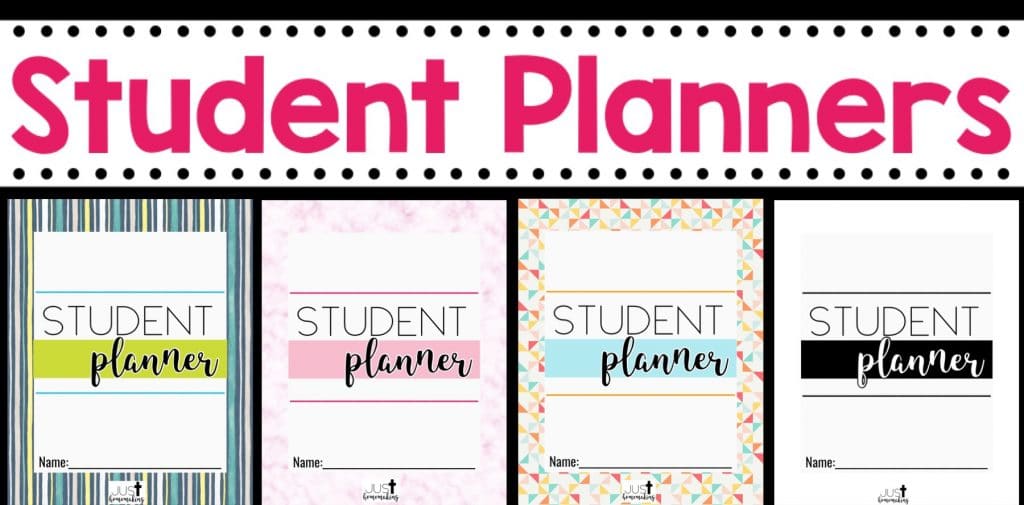
I shared all of this with you because I was super anxious about how the kids would react. After we told them, my husband and I both felt a huge weight lifted off our shoulders. Their reactions were different and more pleasant than we expected. If you’re feeling anxious about this decision, I encourage you to pray and ask the Holy Spirit to lead you, just as in all things.
Homeschooling in Your Area
Before choosing to homeschool, you should probably explore what it would look like in your area. Here are some questions to ponder:
- What are your state laws for homeschooling? Some states are more homeschool-friendly than others. Check out how your state fares here: https://hslda.org/legal
- Is your surrounding area homeschool-supportive? Are there co-ops or groups you can join? Do you have easy access to things like public libraries, parks, etc.? These things obviously aren’t necessary, but they’re certainly helpful.
- Do you have a few places in mind that would make good field trip destinations? Zoos, museums, or canals would be great spots to enhance learning and get you out of the house with your kids.
- Will your local school be an option for participating in extracurricular activities or for connection classes like Art and Music? The answer to this question will likely vary by state and school district. Speaking with a guidance counselor is a great place to start exploring these options.
- Does your community have other options for sports and clubs? Maybe The Y, county sports, etc. In my area, there’s actually a homeschool sports league for middle and high school students.
Research— Who to Trust
Next, you’ll probably want to start looking to others for ideas. Choosing to homeschool is a big step and you’re curious how it works for other people. I know I was and still am!
One thing to keep in mind when seeking the counsel of others (in person and online), is that there are so many different styles and personalities out there. Before taking what someone says or what you read online (including this post!) as gospel, consider whether or not the source shares the same educational philosophies and outlooks as you do. What works for one family may not work for yours.
I’ve found that I prefer an open-and-go curriculum. This way, it’s all put together and allows me to expound on specific areas when my creative juices are flowing. I also realized early on that I wouldn’t find ONE curriculum that would work for my family across the board, so I built our curriculum arsenal eclectically. (More on that in this post.)
Some things to think about before you delve into curriculum:
- What type of homeschooler will you be? What is your personality wired for— rigid scheduling, flying by the seat of your pants, or a happy mix of both? There are no wrong answers here, so be honest with yourself.
- What is your outlook on education? Do you think it should be student-led where your child(ren)’s interests take precedence, or will you (or someone else) decide what’s important for your child(ren) to know?
>>This article does a fantastic job of breaking down the different types of homeschooling. Please keep in mind that your answers to these questions might change and you don’t have to be 100% of any one thing. For instance, I like structure and a plan to keep myself on course, but also need room in that plan to be creative, have an “off” day, or explore something more in depth.
- What type of learner is your child? Does he/she need to see the information, hear it, touch it or move with it, or write it down?
>>This article goes over the 4 main learning styles and how to reach each type of learner effectively.
Also, if you find this type of information incredibly fascinating like I do, might I suggest this book from Dr. Kathy Koch. In 8 Great Smarts, you will have so much fun figuring out which type of smarts your child is wired for, and how that impacts their life. This is one of my FAVORITE books and one I suggest to friends often.
Curriculum Choices are Plentiful
Now that you’ve got an understanding for what type of homeschool will benefit you and your child(ren), you’ll want to start looking at curriculum that will work for you and not against you.
Again, when researching the (ridiculously over-abundant, oftentimes overwhelming) choices that are out there, try to find somebody who seems to have a similar personality and outlook on homeschooling as you do, but you still have to do your own digging. Don’t order what your best friend or the homeschool mom you follow on instagram is using just because you admire them and value their opinion. They are not raising and educating your family — you are!
There are a ton of sites that are devoted to sharing their homeschool experiences and reviewing curriculum. And it’s okay if one curriculum doesn’t meet all your needs. I hereby give you permission to mix and match. Two sites that I found super helpful for curriculum reviews were https://cathyduffyreviews.com/# and https://www.confessionsofahomeschooler.com/
I won’t go into the details of my curriculum picks in this post, but you can read them here.
I will also point out that there are so many resources available, so don’t feel like you have to spend a fortune (whatever that word means to you) on curriculum. From what I’ve seen, homeschooling can be as expensive or cost-efficient as you want/need it to be.
Homeschooling a Large Family
One of my big question marks when choosing to homeschool was how to make it work for our large-ish family. My boys will be starting 8th, 6th, 5th, and 3rd grade… how could I do this?
Thankfully, there are homeschooling veterans who gave me some pointers, and I was able to work some problems out on my own, too.
1. Combine where you can
It may not seem like it at first, but a lot of subjects can be combined. Many people do this through unit studies or family-style curriculum.
Unit studies will focus on one area of a subject. Science is a great subject for the use of unit studies: Energy, Meteorology, Space, Botany, The Human Body, etc. are all separate units of study. You can see all the details about the Science curriculum I’m using here, but this is how my family will study science together.
Family Style Learning is where everyone sits down together and learns the same lesson. You will get different levels of depth from your students based on their ages and maturity. My family will learn History family-style (details here), so although my 3rd grader and my 8th grader will be learning the same historical information, they’re going to absorb it differently.
This reminds me of a period of time at church where the entire congregation, including the children’s Sunday School Classes, was studying the same book. On the drive home, it was always incredible to hear the boys’ takeaways from the lessons and what stuck out to them. We were able to ask each other pointed questions and help fill in any blanks that might have been missed, and the conversation was easily carried into the rest of the week. Family Style Learning will similarly provide those opportunities.
>>Keep some order while educating at home with a Simple Family Command Center
2. Using Quarters and Semesters
Math and English are core subjects, and should really be done daily, year-round. But you don’t have to squeeze in every subject every day, especially if it wears you out.
I decided that I would do History and Science in semesters because then we’re only having to focus on three main subjects a day instead of four. It will allow time to dig deeper into things that are really interesting to the boys, and I can incorporate what we’re learning into other areas, as well. For instance, if they get really into learning about pioneers and the frontier, then we could incorporate some Little House on the Prairie books, spend some time cooking things they would have prepared back then, learn some games and pastimes that were popular entertainment at the time, etc.
It also provides more time to work on life skills and exercise their talents.
This works better for my brain, because it will allow me to be creative and add fun elements in our day without feeling overwhelmed. This may not be true for everyone though, so figure out what works for you!
Scheduling
One of the major benefits of choosing to homeschool is the ability to set your own schedule! There is so much freedom in this area.
1. Yearly Scheduling
Decide how your year will look. Do you want to take traditional breaks and have a full summer off? Are you crazy about Christmas and want to soak in a month’s worth of memory-making by taking off the entire month of December? Do you need mini-breaks regularly and want to try out a system where you do four weeks on, one week off?
The possibilities are endless.
Because I find the weather in Georgia more pleasant from March to May, we are going to aim for taking our “summer break” then. The traditional break of June-August is so hot that we really don’t want to be doing much unless we’re in the water (or air conditioning) anyway. So we can still do a couple hours of schooling in the morning and head to the pool in the thick of summer.
I also don’t plan on schooling five days a week, every week. Some weeks, sure.
We’ll take other breaks here and there, and probably a sizable chunk off around the holidays. Nothing is set in stone yet. We have a few long-weekend trips planned, but the rest of our year is pretty open as of right now.
You can make your school year look however you want it to, provided that you’re meeting your state’s requirements for days and hours spent formally educating.

2. Daily Scheduling
Figure out how you will move from one subject to the next.
Some people may work best by dedicating 9:00 to Math, 10:00 to English, 11:00 to Science, etc. The whole idea of doing it this way stresses me out. What if Math takes 30 minutes… what will that student do with the extra time until English starts? One of my kids is a real nuisance when he has a ton of extra time on his hands.
What if we get super into a Science lesson and want to spend more than an hour doing experiments?
What I’ve decided to do is start with a solid morning routine and then get the family-style learning done first, since we’ll be doing it together.
Next will be the partnered lessons.
And then individual learning.
So our day will roughly look like this:
- 7:00-7:30 Mom’s Coffee Time (DO NOT BOTHER ME) | Boys Wake Up, Morning Hygiene
- 7:35-8:15 Morning Walk/Run/Bike Ride
- 8:20-8:40 Mom Shower | Boys Morning Chore
- 8:45-9:00 Mom Make Breakfast | Boys set up work station
- 9:05-9:40 Eat Breakfast, Calendar, Pledge, Devo
- History/Science (depending on semester)
- Grammar
- ELA
- Mom Make Lunch | Boys Fresh Air
- Eat Lunch
- Round Robin (learn more here)
- Math
- Snack
- Free Time
I’m sure this routine will go through many revisions and amendments. You will undoubtedly figure out what works best for you, too! Don’t be afraid to change things up and experiment until you find your groove.
Lesson Planning
Everyone I talked to encouraged me not to lesson plan beyond a week or two. It makes a lot of sense, because you and your family will need some time to get your feet wet and understand how you will work your way through your curriculums, and how long it takes you to finish lessons.
I absolutely agree with this, but I needed to have an idea of what the first couple weeks would look like.
Do you remember how I said that it’s unlikely we would homeschool five days a week every week? I needed to figure out a way to organize our lessons, but also not rely on a Monday-Friday school week. For instance, if I said Tuesdays and Thursdays were for Science, but Thursday we woke up sick and didn’t get to school, it would be a pain to move everything down a day.
Instead, I am just counting days. So if we’re on Day 12 on a Monday, and don’t do school on that Tuesday, then Wednesday will be Day 13. We will have missed nothing and don’t have to shift anything around. Day 13 can be accomplished any day of the week.
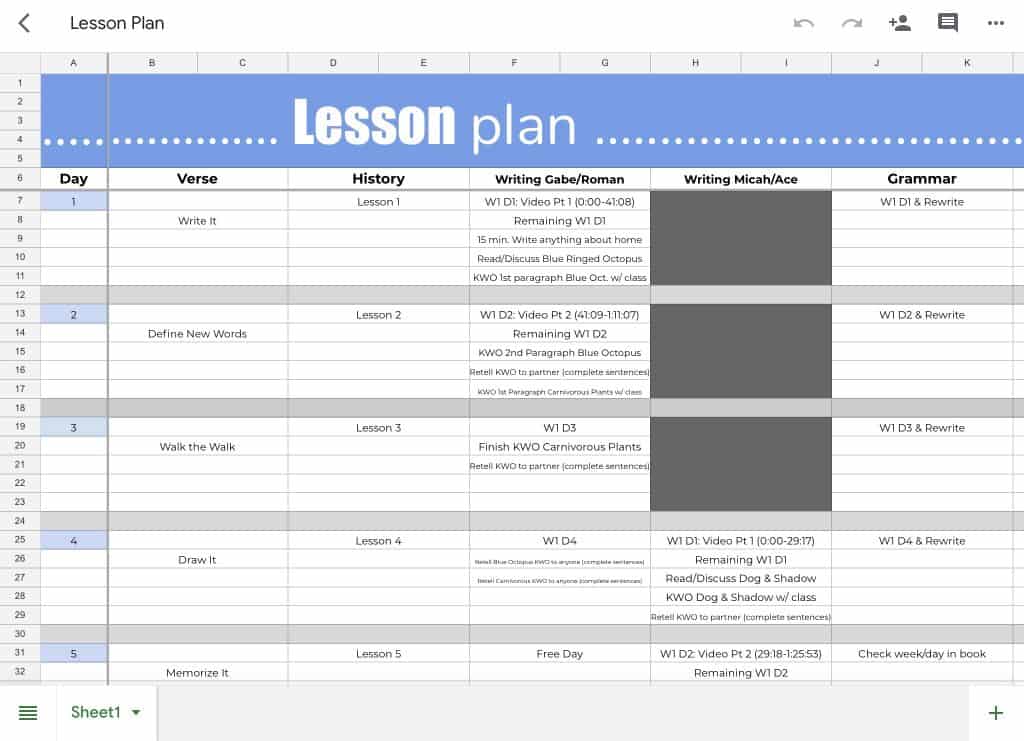
One Random Good Idea
After choosing to homeschool, one of my worries was where to put everything. I don’t have the space for a designated “school room”. And with a large family, I realized that curriculum and other school supplies could quickly take over the whole house (especially the dining room table). Clutter like that stresses me out.
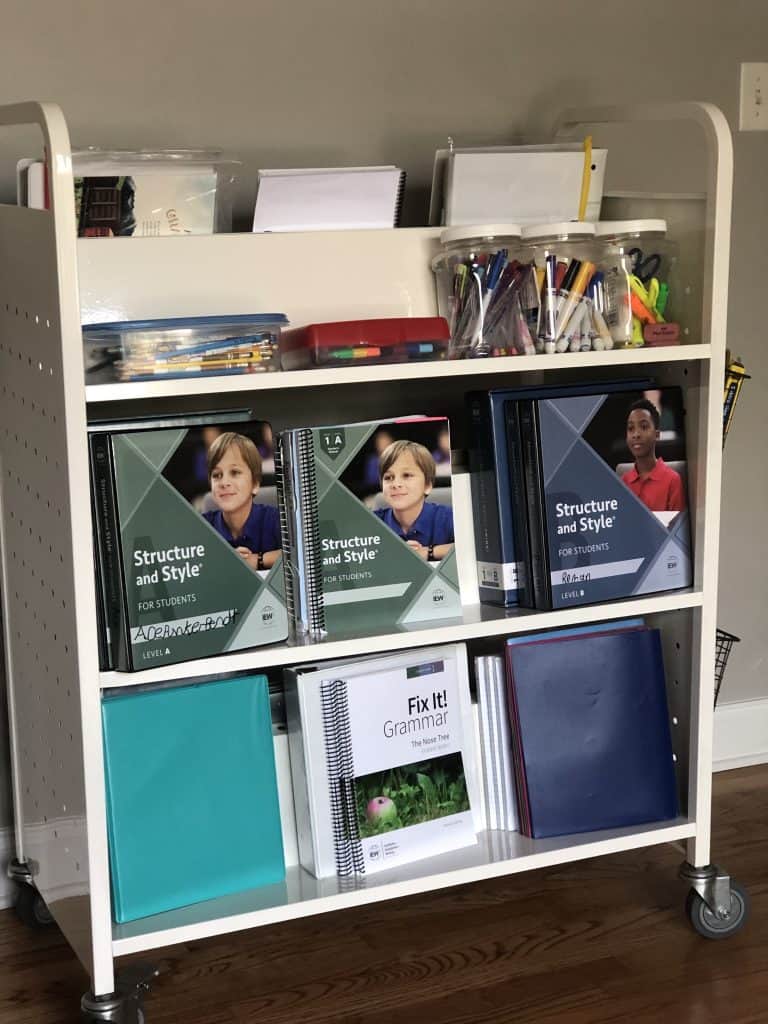
I had a random thought to put all of our curriculum and supplies on a library book cart. I got mine from EBay. The pieces were pretty banged up and misshapen when it arrived, and my husband had to do a lot of clanging and banging to make them fit together properly when assembling it. If you’re into this idea, you might have better luck on Amazon, Facebook Marketplace, or maybe your local library has one to get rid of!
Book Cart link:
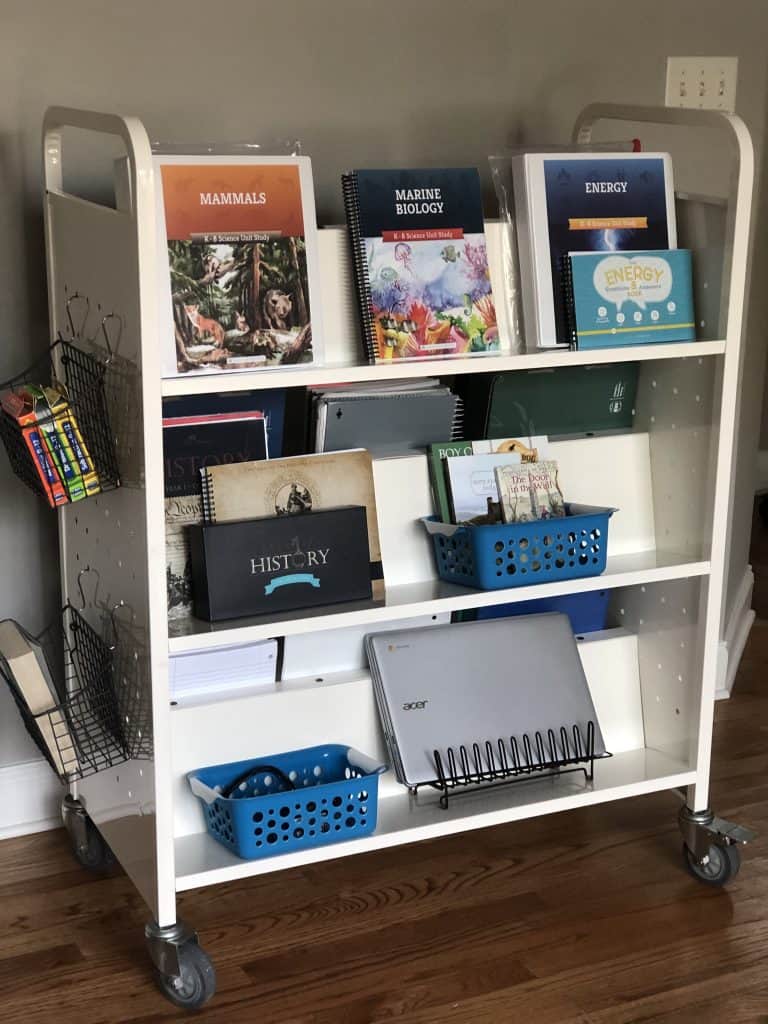
I can separate subjects and have plenty of space for binders, folders, laptops, etc.
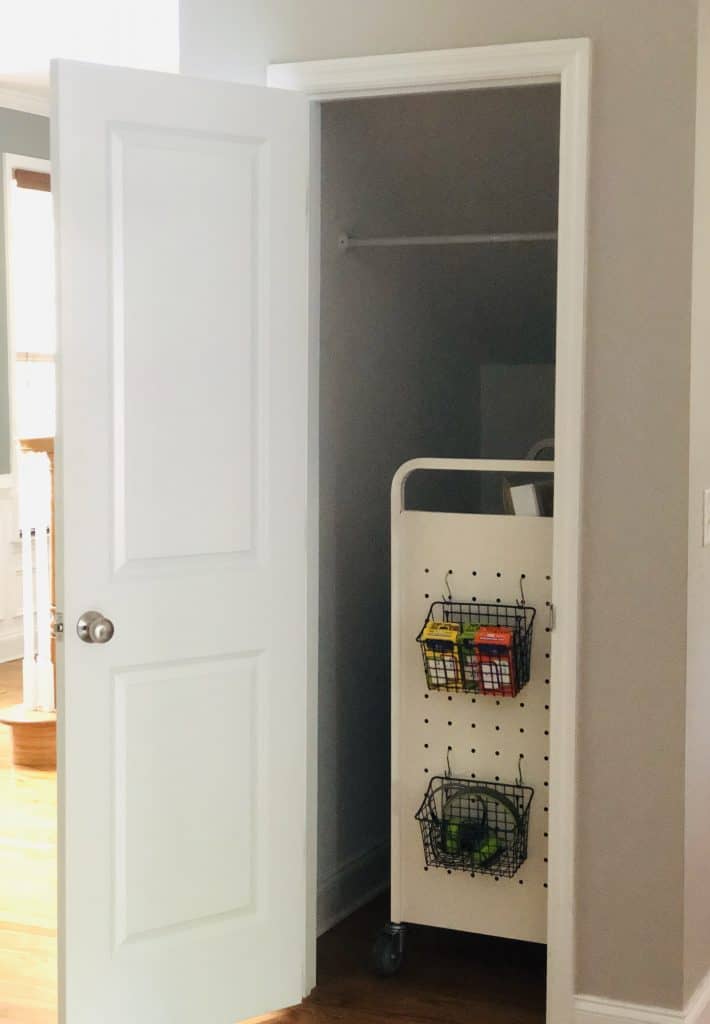
The book cart fits perfectly in the closet under my stairs (proof that I’m not storing a Harry Potter in there). I love that we can pull it out each morning and roll it away every afternoon. And the peg sides allow me to hang baskets (with S-hooks) for additional storage!
Basket link:
S hooks link:
Obviously, this may not work for you. But please don’t feel intimidated by the perfect homeschooling rooms and set-ups you will inevitably see on Pinterest. You are fully capable of working within the confines of your space and creating an environment that will be conducive to learning.
Student Planners
I created these planners with my boys in mind— to help instill accountability, autonomy, organization, and time-management skills. I thought you might like them for your kid(s) too!
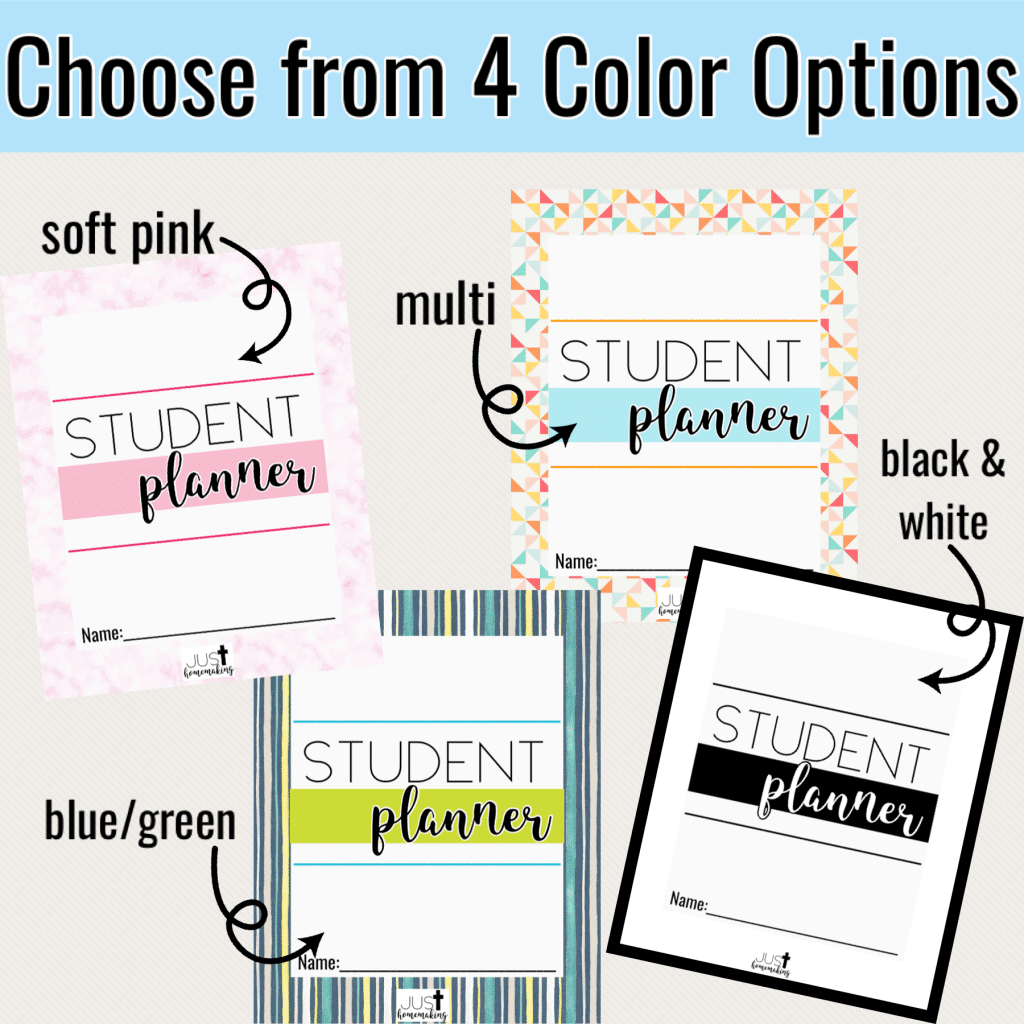
The Student Planners are offered in 4 different colors and come with over 40 stunning pages where everything can be kept in one place.

Your student will learn how to think through a project or paper.
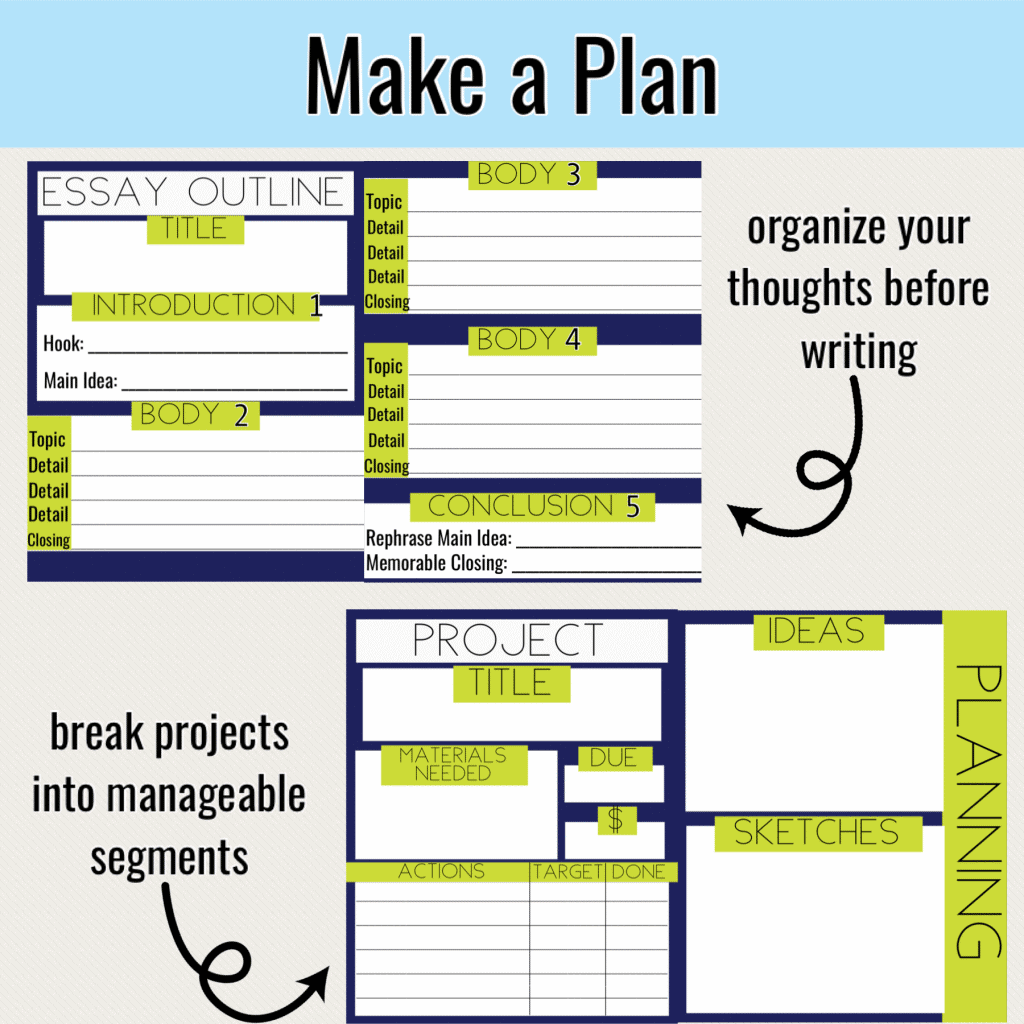
He or she can be responsible for keeping track of assignments, due dates, tests, and other important things throughout their week.
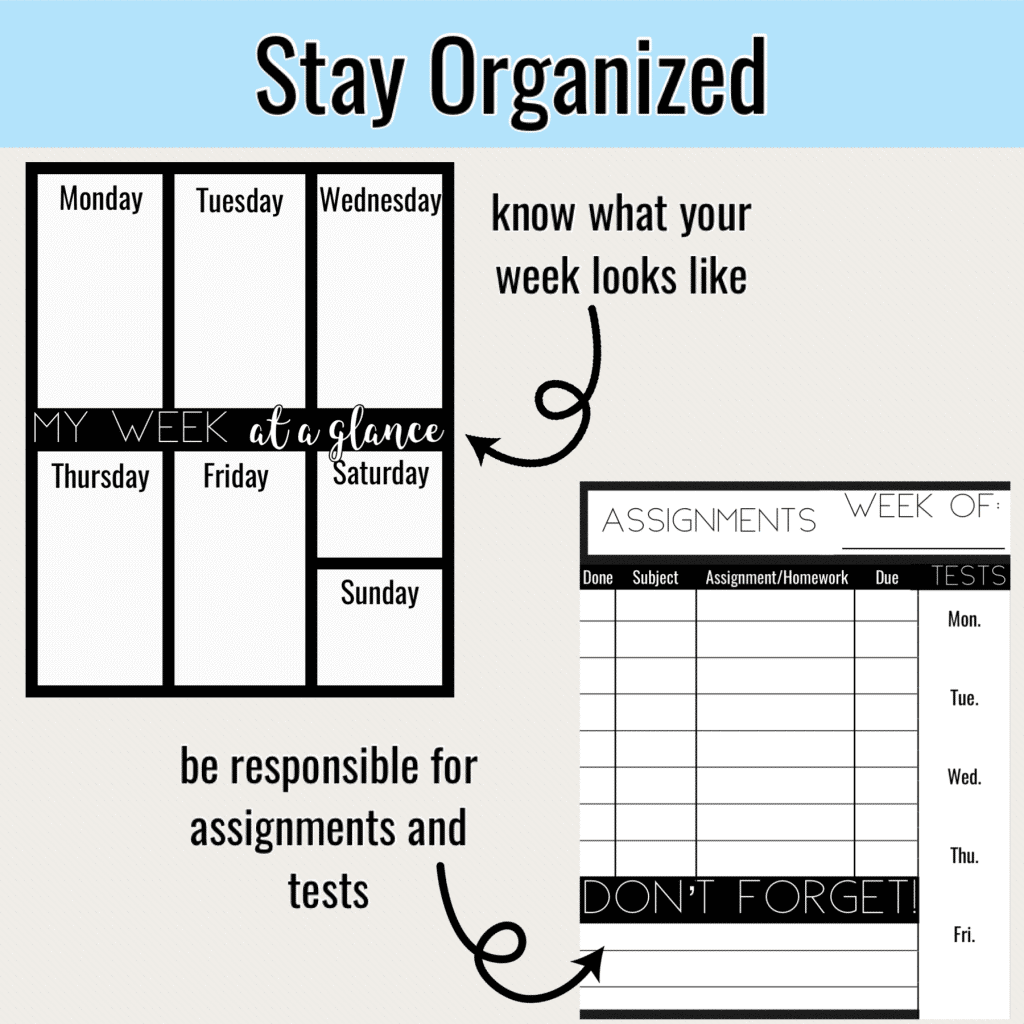
A yearly calendar (through 2023) is provided to help your child(ren) remember important dates.
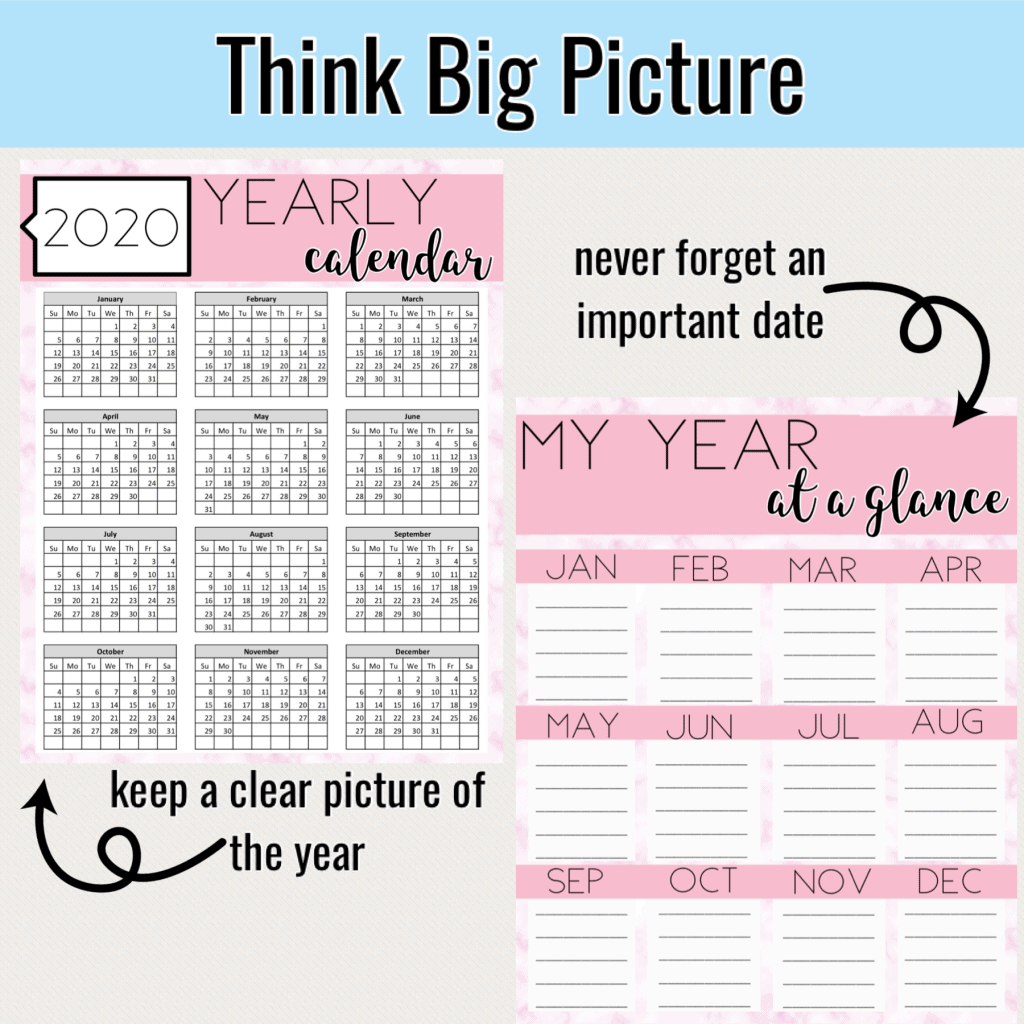
The Student Planner also includes a couple of helpful extras.

The best part? The Student Planners are not dated, so you can buy it ONCE and be able to reprint it each year FOR LIFE. (There are yearly calendars included through 2023, and updated sheets will be available when the time comes). As a frugal consumer myself, I love purchasing something that has re-usability.

>>The planners are printable as a digital download via Google Drive. You can print at home, or at your favorite print shop. Print all pages or just the ones that are applicable to your family’s needs. The pages were designed at a size of 8×10. Personally, I will print them on 8.5×11 cardstock to allow room for 3-hole punching, as my children will be using these planners in binders. You may choose to have yours spiral-bound, or some other system that works for you and your child(ren).
>>>HOW TO GET YOUR HANDS ON THESE AWESOME STUDENT PLANNERS
- To pay full price, use this link.
- To receive an exclusive discount plus access to two free printables, see “Your Special Offer” below.
Your Special Offer
As a thank you, we are offering our newsletter subscribers an exclusive discount of 25% off our Student Planners, plus these free printables to help with maintaining some order to your homeschool environment.
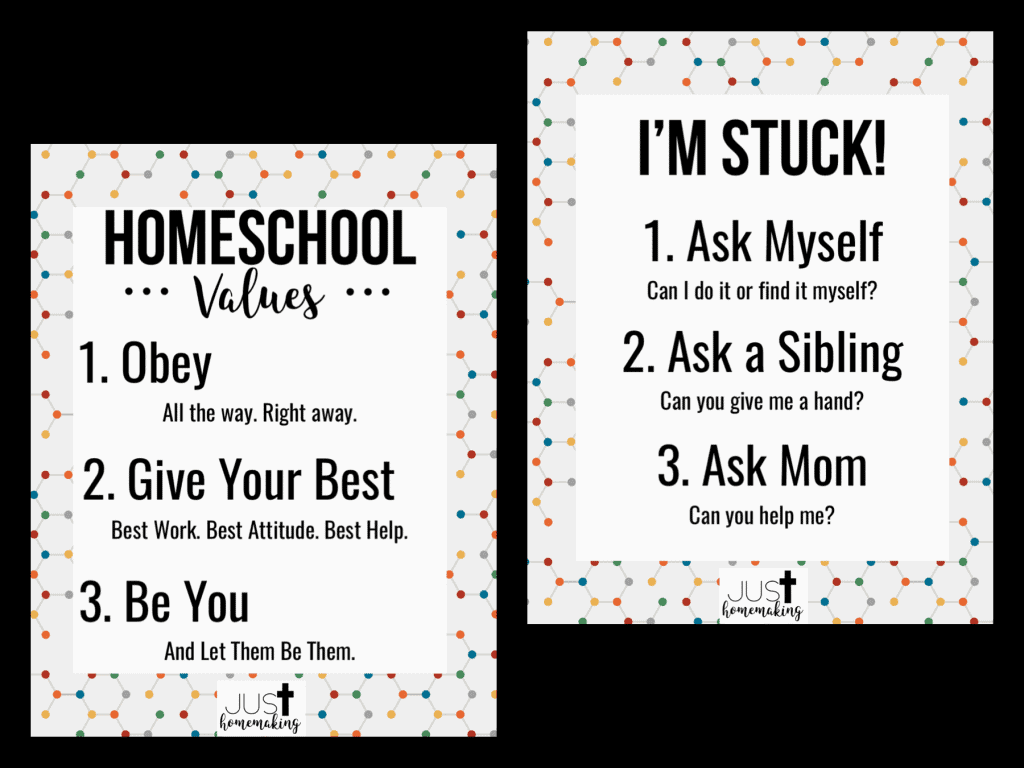
As a new subscriber, you can expect one e-newsletter in your inbox weekly, and can unsubscribe at any time. But you probably won’t want to because our newsletters are full of goodies like:
- First Access to Blog Posts
- Tips & Tricks
- Motivating Challenges
- Free Printables (like these!)
- First looks and discounts on new products
- & More!
>>>Ready for your discount and free printables?! Tap here.
I Hope This Was Helpful
Choosing to homeschool leaves you with a lot of work and research to do. It’s very easy to feel overwhelmed. I hope you found this post helpful and encouraging.
I definitely don’t have all the answers… or even most of the answers. I’m sure there are veteran homeschool moms chuckling to themselves as they read this with a quiet knowledge that I have a lot to learn and so many experiences still to walk through. But please know that you are not alone in feeling a pull on your heart to begin homeschooling, or at the very least, to view it with fresh eyes and as a realer option than ever before.
Please let me know if you have any questions about choosing to homeschool, and I will try my very best to answer them, or guide you to a source that can.
More of our Resources:



(20+ year veteran homeschooler here) I never do school on Fridays. This way I can plan the grocery shopping and all our errands for Friday and not have to mess with them the rest of the week. It helps 🙂 We take from Thanksgiving to New Years off for our “summer vacation” just cause its what works for us. Like Georgia, Nevada is too hot to do anything but sit in front of the AC in the summer anyway. Might as well do book work.
I have not heard the term “Family Learning” before, but it describes it perfectly. Especially when i had a bunch of littles and middles (I have 9dc) We did that for Bible Study, History, Science, and any other subject I could! Now that I only have one middler (he’s 8) and not littles (Plus 3 teens and 5 graduated), it’s easier to have everyone doing their own thing in most subjects. But “Family Learning” was a life savor in those early years!
Welcome to the ranks of homeschoolers. It is a lifestyle well worth the effort. There eise nothing like watching your children learn 🙂
Wow, Betty— 20 years! Amazing! Thank you so much for the encouragement, kind words, and insight into how homeschool looks for your family. I’m so excited for this journey. ❤️